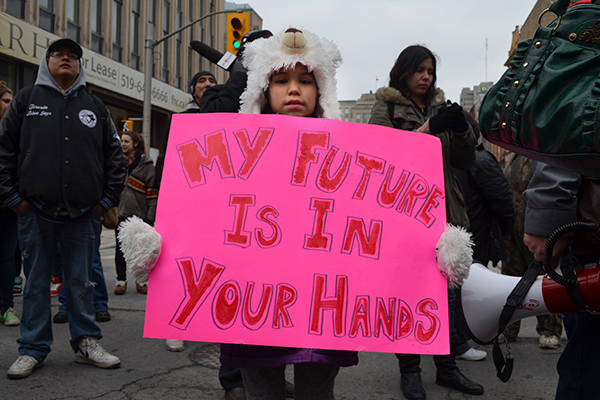It was hailed as Canada’s last chance to make amends. But 25 years on, it seems most aboriginals agree the Royal Commission on Aboriginal Peoples failed to restore Canada’s relationship with indigenous peoples.
“It was virtually ignored and laid to gather dust,” says former commissioner Paul Chartrand, who represented Métis people.
Chartrand remembers aboriginal organizations rallying behind the commission’s recommendations. But faced with government inaction, fervour soon gave way to disappointment. “The shouts turned to murmurs, and the murmurs died away.”
Established in 1991, the commission was born of growing clashes between aboriginals and non-aboriginals. These tensions had reached a flashpoint in the 1990 Oka Crisis: the 78-day standoff that pitted Canadian soldiers against Mohawks from the Quebec community of Kanesatake over a land dispute.
Then Prime Minister Brian Mulroney gave the commission an ambitious mandate — to redress “literally centuries of injustice.” By the time the commission released its report in 1996, its costs had ballooned to $58 million, making it the most expensive royal commission in Canadian history.
The commissioners roundly condemned Canada’s long-standing assimilationist policies. Their report contained 440 recommendations, setting out a twenty-year plan to address indigenous issues: from self-governance to resources, economic development to social and cultural affairs.
But when asked about the commission’s legacy, Chartrand offers a bleak assessment: “None of the significant foundational recommendations were ever accepted.”
In response to the commission’s findings, Liberal Minister of Indian Affairs Jane Stewart apologized in 1998 to residential school survivors. “To those of you who suffered this tragedy, we are deeply sorry,” she said.
Unfortunately, to many aboriginal observers, that’s where the government’s efforts ended.
“That was the one public statement that I think captured the Canadian imagination for at least a news day,” says Cindy Blackstock, who heads the First Nations Child and Family Caring Society. “Then it faded into the white noise of Canadian society.”
Ten years later, Prime Minister Stephen Harper again apologized for Canada’s residential schools — but not before scrapping the Kelowna Accord in 2006. Endorsed a year earlier by Paul Martin’s Liberal government, the agreement would have provided $5 billion towards Aboriginal education, employment, housing and health. The Conservatives committed $450 million.
Little progress has been made against the litany of problems facing aboriginals. Inadequate housing remains a reality in many indigenous communities, as was seen in 2011 in Attawapiskat. Despite representing only three per cent of Canada’s population, aboriginal adults make up a quarter of inmates in provincial and territorial jails. First Nations youth remain five to six times more likely to commit suicide than their non-aboriginal peers.
And aboriginal leaders struggle to spur Ottawa into action. “I never anticipated how difficult it would be to get the federal government to respond to basic equity issues for children,” says Blackstock. Blackstock recently won a nine-year-long legal battle against the federal government before the Canadian Human Rights Tribunal, which found Ottawa provides far less child welfare funding to on-reserve children than provinces do off-reserve.
But Hayden King, director of Ryerson University’s Centre for Indigenous Governance, remains optimistic. He says the commission’s work offers a path forward, pointing to the Idle No More protest movement.

“Canadians were just losing their minds. ‘What do the Indians want?’” King says the commission’s report “was a helpful device for people to put forward and say, ‘If you’re curious, give this a read. Take a look at this. Understand your own history to better understand what we’re asking for.’”
Now that the Liberal government has committed to carrying out all 94 of the Truth and Reconciliation Commission’s recommendations, aboriginals can only hope history won’t again repeat itself.
———
Documentation – 1
a) Institute on Governance. (2014). Revisiting RCAP. Towards Reconciliation: The Future of Indigenous Governance. Symposium Discussion Paper.
b) I found this discussion paper through a Google search early in my research process. Considering the breadth of the commission’s actual report (i.e. close to 4,000 pages), I was looking for an effective summary of the commission’s work and recommendations, as well as developments since the release of its report.
c) This discussion paper was an extremely valuable reference throughout my research and writing process. It provided a useful overview of the commission’s work and recommendations, quickly bringing me up to speed in advance of my interviews. It was also a useful resource while conducting those interviews; having marked up a paper copy, I was able to flip back and forth between relevant sections while discussing various aspects of the commission’s work with my sources.
Documentation – 2
a) Feschuk, S. and Platiel, R. (November 22, 1996). The Globe and Mail. Natives warn Ottawa not to ignore report.
b) I found this press clipping through ProQuest’s Historical Newspapers database, available through Ryerson University. More specifically, I searched for articles published near the date of the release of the commission’s final report.
c) This article was helpful in gaining a sense of the initial reaction from both aboriginal leadership and the federal government immediately following the release of the commission’s report. Besides providing insight into the reasons behind the government’s slow response, this information helped inform my line of questioning for all four of my interviews.
